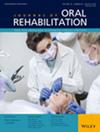To identify the available evidence on the ultrasonographic characteristics of masticatory muscles in subjects with myogenous TMD, as well as the potential use of ultrasonography as a diagnostic and treatment assessment outcomes tool.
An electronic search of the PubMed, Web of Science and Scopus databases was performed using the following terms: ‘ultrasonography’, ‘ultrasound’, ‘masseter’, ‘temporal’, ‘masticatory muscles’, ‘temporomandibular disorders’, ‘temporomandibular joint disorders’. Full-text articles were obtained from the records after applying the inclusion/exclusion criteria.
Thirteen articles were included for analysis: one comparative cross-sectional study, five case–control studies, six clinical trials and one randomised clinical trial. Main ultrasonographic characteristic assessed were local cross-sectional dimension and intramuscular ultrasonographic appearance. Retrieved studies reported the use ultrasonography for diagnosis or treatment assessment purposes showing heterogeneous results. For diagnosis purposes, the results of local cross-sectional dimension are not consistent; therefore, its diagnostic value for myogenous TMD diagnosis is weak. However, more homogeneous results were observed for intramuscular ultrasonographic appearance showing a higher prevalence of type-II pattern in myogenous TMD subjects than non-TMD subjects. On the other hand, for treatment assessment purposes, muscles were observed thinner after treatment compared to pre-treatment. Also, results of intramuscular ultrasonographic appearance show disappearance or reduction of anechoic areas, higher prevalence of type-II pattern and significant distinction of echogenic bands were observed after treating TMD subjects.
Ultrasonography cannot be considered as a diagnostic instrument, but maybe as a complementary tool for treatment assessment of myogenous TMD subjects, even though future research is required to confirm its utility.


